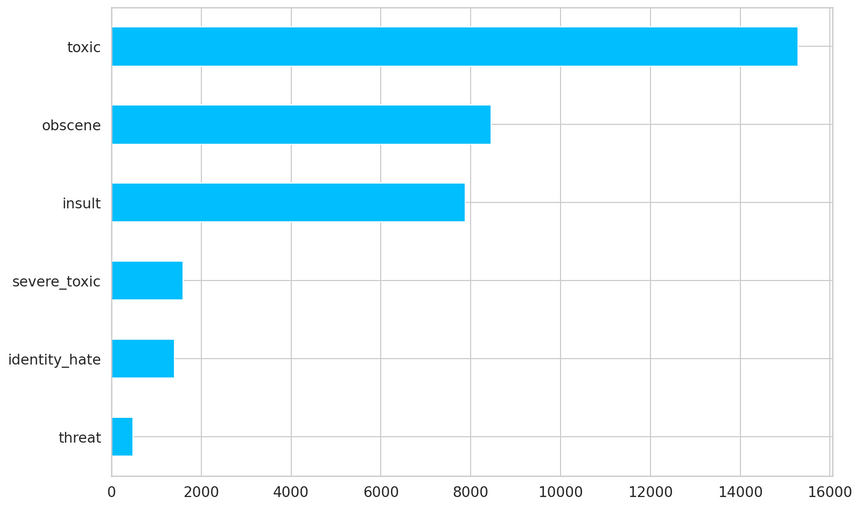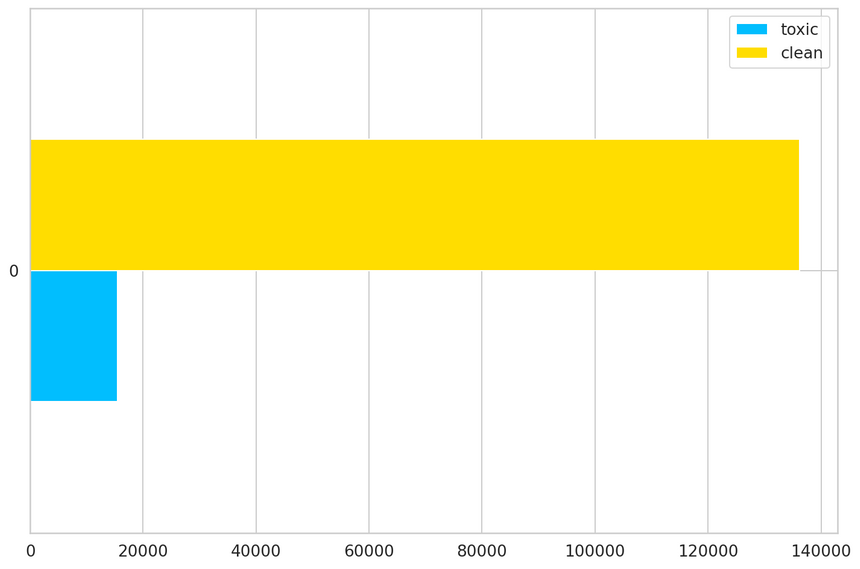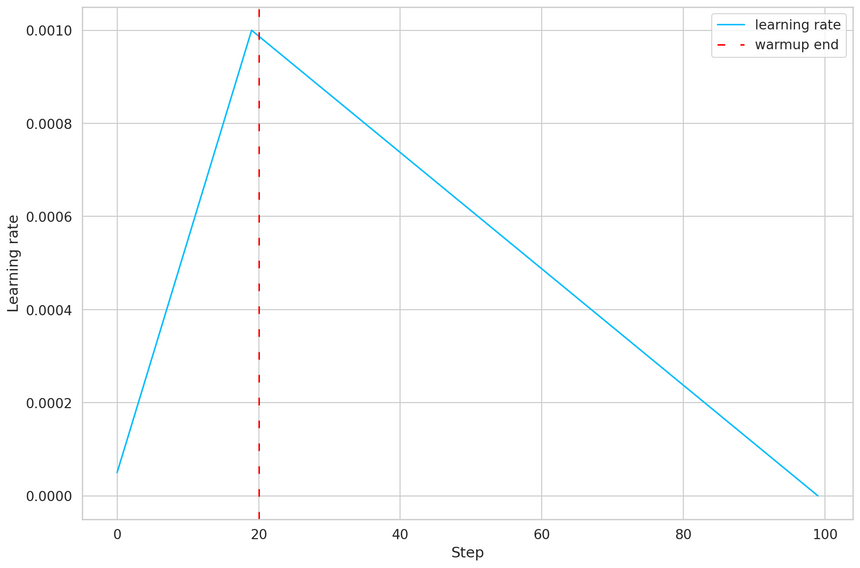Multi-label Text Classification with BERT and PyTorch Lightning
— Deep Learning, NLP, Neural Network, PyTorch, Python — 5 min read
Share
TL;DR Learn how to prepare a dataset with toxic comments for multi-label text classification (tagging). We’ll fine-tune BERT using PyTorch Lightning and evaluate the model.
Multi-label text classification (or tagging text) is one of the most common tasks you’ll encounter when doing NLP. Modern Transformer-based models (like BERT) make use of pre-training on vast amounts of text data that makes fine-tuning faster, use fewer resources and more accurate on small(er) datasets.
In this tutorial, you’ll learn how to:
- Load, balance and split text data into sets
- Tokenize text (with BERT tokenizer) and create PyTorch dataset
- Fine-tune BERT model with PyTorch Lightning
- Find out about warmup steps and use a learning rate scheduler
- Use area under the ROC and binary cross-entropy to evaluate the model during training
- How to make predictions using the fine-tuned BERT model
- Evaluate the performance of the model for each class (possible comment tag)
Will our model be any good for toxic text detection?
1import pandas as pd2import numpy as np34from tqdm.auto import tqdm56import torch7import torch.nn as nn8from torch.utils.data import Dataset, DataLoader910from transformers import BertTokenizerFast as BertTokenizer, BertModel, AdamW, get_linear_schedule_with_warmup1112import pytorch_lightning as pl13from pytorch_lightning.metrics.functional import accuracy, f1, auroc14from pytorch_lightning.callbacks import ModelCheckpoint, EarlyStopping15from pytorch_lightning.loggers import TensorBoardLogger1617from sklearn.model_selection import train_test_split18from sklearn.metrics import classification_report, multilabel_confusion_matrix1920import seaborn as sns21from pylab import rcParams22import matplotlib.pyplot as plt23from matplotlib import rc2425%matplotlib inline26%config InlineBackend.figure_format='retina'2728RANDOM_SEED = 422930sns.set(style='whitegrid', palette='muted', font_scale=1.2)31HAPPY_COLORS_PALETTE = ["#01BEFE", "#FFDD00", "#FF7D00", "#FF006D", "#ADFF02", "#8F00FF"]32sns.set_palette(sns.color_palette(HAPPY_COLORS_PALETTE))33rcParams['figure.figsize'] = 12, 83435pl.seed_everything(RANDOM_SEED)Data
Our dataset contains potentially offensive (toxic) comments and comes from the Toxic Comment Classification Challenge. Let’s start by download the data (from Google Drive):
1!gdown --id 1VuQ-U7TtggShMeuRSA_hzC8qGDl2LRkrLet’s load and look at the data:
1df = pd.read_csv("toxic_comments.csv")2df.head()| id | comment_text | toxic | severe_toxic | obscene | threat | insult | identity_hate | |
|---|---|---|---|---|---|---|---|---|
| 0 | 0000997932d777bf | Explanation\nWhy the edits made under my usern... | 0 | 0 | 0 | 0 | 0 | 0 |
| 1 | 000103f0d9cfb60f | D'aww! He matches this background colour I'm s... | 0 | 0 | 0 | 0 | 0 | 0 |
| 2 | 000113f07ec002fd | Hey man, I'm really not trying to edit war. It... | 0 | 0 | 0 | 0 | 0 | 0 |
| 3 | 0001b41b1c6bb37e | "\nMore\nI can't make any real suggestions on ... | 0 | 0 | 0 | 0 | 0 | 0 |
| 4 | 0001d958c54c6e35 | You, sir, are my hero. Any chance you remember... | 0 | 0 | 0 | 0 | 0 | 0 |
We have text (comment) and six different toxic labels. Note that we have clean content, too.
Let’s split the data:
1train_df, val_df = train_test_split(df, test_size=0.05)2train_df.shape, val_df.shape1((151592, 8), (7979, 8))Preprocessing
Let’s look at the distribution of the labels:
1LABEL_COLUMNS = df.columns.tolist()[2:]2df[LABEL_COLUMNS].sum().sort_values().plot(kind="barh");
We have a severe case of imbalance. But that is not the full picture. What about the toxic vs clean comments?
1train_toxic = train_df[train_df[LABEL_COLUMNS].sum(axis=1) > 0]2train_clean = train_df[train_df[LABEL_COLUMNS].sum(axis=1) == 0]34pd.DataFrame(dict(5 toxic=[len(train_toxic)],6 clean=[len(train_clean)]7)).plot(kind='barh');
Again, we have a severe imbalance in favor of the clean comments. To combat this, we’ll sample 15,000 examples from the clean comments and create a new training set:
1train_df = pd.concat([2 train_toxic,3 train_clean.sample(15_000)4])56train_df.shape, val_df.shape1((30427, 8), (7979, 8))Tokenization
We need to convert the raw text into a list of tokens. For that, we’ll use the built-in BertTokenizer:
1BERT_MODEL_NAME = 'bert-base-cased'2tokenizer = BertTokenizer.from_pretrained(BERT_MODEL_NAME)Let’s try it out on a sample comment:
1sample_row = df.iloc[16]2sample_comment = sample_row.comment_text3sample_labels = sample_row[LABEL_COLUMNS]45print(sample_comment)6print()7print(sample_labels.to_dict())1Bye!23Don't look, come or think of comming back! Tosser.45{'toxic': 1, 'severe_toxic': 0, 'obscene': 0, 'threat': 0, 'insult': 0, 'identity_hate': 0}1encoding = tokenizer.encode_plus(2 sample_comment,3 add_special_tokens=True,4 max_length=512,5 return_token_type_ids=False,6 padding="max_length",7 return_attention_mask=True,8 return_tensors='pt',9)1011encoding.keys()1dict_keys(['input_ids', 'attention_mask'])1encoding["input_ids"].shape, encoding["attention_mask"].shape1(torch.Size([1, 512]), torch.Size([1, 512]))The result of the encoding is a dictionary with token ids input_ids and an attention mask attention_mask (which tokens should be used by the model 1 - use or 0 - don’t use).
Let’s look at their contents:
1encoding["input_ids"].squeeze()[:20]1tensor([ 101, 17774, 106, 1790, 112, 189, 1440, 117, 1435, 1137,2 1341, 1104, 3254, 5031, 1171, 106, 1706, 14607, 119, 102])1encoding["attention_mask"].squeeze()[:20]1tensor([1, 1, 1, 1, 1, 1, 1, 1, 1, 1, 1, 1, 1, 1, 1, 1, 1, 1, 1, 1])You can also inverse the tokenization and get back (kinda) the words from the token ids:
1print(tokenizer.convert_ids_to_tokens(encoding["input_ids"].squeeze())[:20])1['[CLS]', 'Bye', '!', 'Don', "'", 't', 'look', ',', 'come', 'or', 'think', 'of', 'com', '##ming', 'back', '!', 'To', '##sser', '.', '[SEP]']We need to specify the maximum number of tokens when encoding (512 is the maximum we can do). Let’s check the number of tokens per comment:
1token_counts = []23for _, row in train_df.iterrows():4 token_count = len(tokenizer.encode(5 row["comment_text"],6 max_length=512,7 truncation=True8 ))9 token_counts.append(token_count)1sns.histplot(token_counts)2plt.xlim([0, 512]);
Most of the comments contain less than 300 tokens or more than 512. So, we’ll stick with the limit of 512.
1MAX_TOKEN_COUNT = 512Dataset
We’ll wrap the tokenization process in a PyTorch Dataset, along with converting the labels to tensors:
1class ToxicCommentsDataset(Dataset):23 def __init__(4 self,5 data: pd.DataFrame,6 tokenizer: BertTokenizer,7 max_token_len: int = 1288 ):9 self.tokenizer = tokenizer10 self.data = data11 self.max_token_len = max_token_len1213 def __len__(self):14 return len(self.data)1516 def __getitem__(self, index: int):17 data_row = self.data.iloc[index]1819 comment_text = data_row.comment_text20 labels = data_row[LABEL_COLUMNS]2122 encoding = self.tokenizer.encode_plus(23 comment_text,24 add_special_tokens=True,25 max_length=self.max_token_len,26 return_token_type_ids=False,27 padding="max_length",28 truncation=True,29 return_attention_mask=True,30 return_tensors='pt',31 )3233 return dict(34 comment_text=comment_text,35 input_ids=encoding["input_ids"].flatten(),36 attention_mask=encoding["attention_mask"].flatten(),37 labels=torch.FloatTensor(labels)38 )Let’s have a look at a sample item from the dataset:
1train_dataset = ToxicCommentsDataset(2 train_df,3 tokenizer,4 max_token_len=MAX_TOKEN_COUNT5)67sample_item = train_dataset[0]8sample_item.keys()1dict_keys(['comment_text', 'input_ids', 'attention_mask', 'labels'])1sample_item["comment_text"]1'Hi, ya fucking idiot. ^_^'1sample_item["labels"]1tensor([1., 0., 1., 0., 1., 0.])1sample_item["input_ids"].shape1torch.Size([512])Let’s load the BERT model and pass a sample of batch data through:
1bert_model = BertModel.from_pretrained(BERT_MODEL_NAME, return_dict=True)23sample_batch = next(iter(DataLoader(train_dataset, batch_size=8, num_workers=2)))4sample_batch["input_ids"].shape, sample_batch["attention_mask"].shape1(torch.Size([8, 512]), torch.Size([8, 512]))1output = bert_model(sample_batch["input_ids"], sample_batch["attention_mask"])1output.last_hidden_state.shape, output.pooler_output.shape1(torch.Size([8, 512, 768]), torch.Size([8, 768]))The 768 dimension comes from the BERT hidden size:
1bert_model.config.hidden_size1768The larger version of BERT has more attention heads and a larger hidden size.
We’ll wrap our custom dataset into a LightningDataModule:
1class ToxicCommentDataModule(pl.LightningDataModule):23 def __init__(self, train_df, test_df, tokenizer, batch_size=8, max_token_len=128):4 super().__init__()5 self.batch_size = batch_size6 self.train_df = train_df7 self.test_df = test_df8 self.tokenizer = tokenizer9 self.max_token_len = max_token_len1011 def setup(self, stage=None):12 self.train_dataset = ToxicCommentsDataset(13 self.train_df,14 self.tokenizer,15 self.max_token_len16 )1718 self.test_dataset = ToxicCommentsDataset(19 self.test_df,20 self.tokenizer,21 self.max_token_len22 )2324 def train_dataloader(self):25 return DataLoader(26 self.train_dataset,27 batch_size=self.batch_size,28 shuffle=True,29 num_workers=230 )3132 def val_dataloader(self):33 return DataLoader(34 self.test_dataset,35 batch_size=self.batch_size,36 num_workers=237 )3839 def test_dataloader(self):40 return DataLoader(41 self.test_dataset,42 batch_size=self.batch_size,43 num_workers=244 )ToxicCommentDataModule encapsulates all data loading logic and returns the necessary data loaders. Let’s create an instance of our data module:
1N_EPOCHS = 102BATCH_SIZE = 1234data_module = ToxicCommentDataModule(5 train_df,6 val_df,7 tokenizer,8 batch_size=BATCH_SIZE,9 max_token_len=MAX_TOKEN_COUNT10)Model
Our model will use a pre-trained BertModel and a linear layer to convert the BERT representation to a classification task. We’ll pack everything in a LightningModule:
1class ToxicCommentTagger(pl.LightningModule):23 def __init__(self, n_classes: int, n_training_steps=None, n_warmup_steps=None):4 super().__init__()5 self.bert = BertModel.from_pretrained(BERT_MODEL_NAME, return_dict=True)6 self.classifier = nn.Linear(self.bert.config.hidden_size, n_classes)7 self.n_training_steps = n_training_steps8 self.n_warmup_steps = n_warmup_steps9 self.criterion = nn.BCELoss()1011 def forward(self, input_ids, attention_mask, labels=None):12 output = self.bert(input_ids, attention_mask=attention_mask)13 output = self.classifier(output.pooler_output)14 output = torch.sigmoid(output)15 loss = 016 if labels is not None:17 loss = self.criterion(output, labels)18 return loss, output1920 def training_step(self, batch, batch_idx):21 input_ids = batch["input_ids"]22 attention_mask = batch["attention_mask"]23 labels = batch["labels"]24 loss, outputs = self(input_ids, attention_mask, labels)25 self.log("train_loss", loss, prog_bar=True, logger=True)26 return {"loss": loss, "predictions": outputs, "labels": labels}2728 def validation_step(self, batch, batch_idx):29 input_ids = batch["input_ids"]30 attention_mask = batch["attention_mask"]31 labels = batch["labels"]32 loss, outputs = self(input_ids, attention_mask, labels)33 self.log("val_loss", loss, prog_bar=True, logger=True)34 return loss3536 def test_step(self, batch, batch_idx):37 input_ids = batch["input_ids"]38 attention_mask = batch["attention_mask"]39 labels = batch["labels"]40 loss, outputs = self(input_ids, attention_mask, labels)41 self.log("test_loss", loss, prog_bar=True, logger=True)42 return loss4344 def training_epoch_end(self, outputs):4546 labels = []47 predictions = []48 for output in outputs:49 for out_labels in output["labels"].detach().cpu():50 labels.append(out_labels)51 for out_predictions in output["predictions"].detach().cpu():52 predictions.append(out_predictions)5354 labels = torch.stack(labels).int()55 predictions = torch.stack(predictions)5657 for i, name in enumerate(LABEL_COLUMNS):58 class_roc_auc = auroc(predictions[:, i], labels[:, i])59 self.logger.experiment.add_scalar(f"{name}_roc_auc/Train", class_roc_auc, self.current_epoch)606162 def configure_optimizers(self):6364 optimizer = AdamW(self.parameters(), lr=2e-5)6566 scheduler = get_linear_schedule_with_warmup(67 optimizer,68 num_warmup_steps=self.n_warmup_steps,69 num_training_steps=self.n_training_steps70 )7172 return dict(73 optimizer=optimizer,74 lr_scheduler=dict(75 scheduler=scheduler,76 interval='step'77 )78 )Most of the implementation is just a boilerplate. Two points of interest are the way we configure the optimizers and calculating the area under ROC. We’ll dive a bit deeper into those next.
Optimizer scheduler
The job of a scheduler is to change the learning rate of the optimizer during training. This might lead to better performance of our model. We’ll use the get_linear_schedule_with_warmup.
Let’s have a look at a simple example to make things clearer:
1dummy_model = nn.Linear(2, 1)23optimizer = AdamW(params=dummy_model.parameters(), lr=0.001)45warmup_steps = 206total_training_steps = 10078scheduler = get_linear_schedule_with_warmup(9 optimizer,10 num_warmup_steps=warmup_steps,11 num_training_steps=total_training_steps12)1314learning_rate_history = []1516for step in range(total_training_steps):17 optimizer.step()18 scheduler.step()19 learning_rate_history.append(optimizer.param_groups[0]['lr'])1plt.plot(learning_rate_history, label="learning rate")2plt.axvline(x=warmup_steps, color="red", linestyle=(0, (5, 10)), label="warmup end")3plt.legend()4plt.xlabel("Step")5plt.ylabel("Learning rate")6plt.tight_layout();
We simulate 100 training steps and tell the scheduler to warm up for the first 20. The learning rate grows to the initial fixed value of 0.001 during the warm-up and then goes down (linearly) to 0.
To use the scheduler, we need to calculate the number of training and warm-up steps. The number of training steps per epoch is equal to number of training examples / batch size. The number of total training steps is training steps per epoch * number of epochs:
1steps_per_epoch=len(train_df) // BATCH_SIZE2total_training_steps = steps_per_epoch * N_EPOCHSWe’ll use a fifth of the training steps for a warm-up:
1warmup_steps = total_training_steps // 52warmup_steps, total_training_steps1(5070, 25350)We can now create an instance of our model:
1model = ToxicCommentTagger(2 n_classes=len(LABEL_COLUMNS),3 n_warmup_steps=warmup_steps,4 n_training_steps=total_training_steps5)Evaluation
Multi-label classification boils down to doing binary classification for each label/tag.
We’ll use Binary Cross Entropy to measure the error for each label. PyTorch has BCELoss, which we’re going to combine with a sigmoid function (as we did in the model implementation). Let’s look at an example:
1criterion = nn.BCELoss()23prediction = torch.FloatTensor(4 [10.95873564, 1.07321467, 1.58524066, 0.03839076, 15.72987556, 1.09513213]5)6labels = torch.FloatTensor(7 [1., 0., 0., 0., 1., 0.]8)1torch.sigmoid(prediction)1tensor([1.0000, 0.7452, 0.8299, 0.5096, 1.0000, 0.7493])1criterion(torch.sigmoid(prediction), labels)1tensor(0.8725)We can use the same approach to calculate the loss of the predictions:
1_, predictions = model(sample_batch["input_ids"], sample_batch["attention_mask"])2predictions1tensor([[0.3963, 0.6318, 0.6543, 0.5179, 0.4099, 0.4998],2 [0.4008, 0.6165, 0.6733, 0.5460, 0.4378, 0.5083],3 [0.3877, 0.6185, 0.6830, 0.5238, 0.4326, 0.5138],4 [0.3910, 0.6206, 0.6658, 0.5431, 0.4396, 0.5002],5 [0.3792, 0.6241, 0.6508, 0.5347, 0.4374, 0.5110],6 [0.4069, 0.6106, 0.7019, 0.5484, 0.4450, 0.4995],7 [0.3861, 0.6135, 0.6867, 0.5179, 0.4525, 0.5188],8 [0.3819, 0.6081, 0.6821, 0.5227, 0.4419, 0.5246]],9 grad_fn=<SigmoidBackward>)1criterion(predictions, sample_batch["labels"])1tensor(0.8056, grad_fn=<BinaryCrossEntropyBackward>)ROC Curve
Another metric we’re going to use is the area under the Receiver operating characteristic (ROC) for each tag. ROC is created by plotting the True Positive Rate (TPR) vs False Positive Rate (FPR):
TPR=TP+FNTPFPR=FP+TNFP1from sklearn import metrics23fpr = [0. , 0. , 0. , 0.02857143, 0.02857143,4 0.11428571, 0.11428571, 0.2 , 0.4 , 1. ]56tpr = [0. , 0.01265823, 0.67202532, 0.76202532, 0.91468354,7 0.97468354, 0.98734177, 0.98734177, 1. , 1. ]89_, ax = plt.subplots()10ax.plot(fpr, tpr, label="ROC")11ax.plot([0.05, 0.95], [0.05, 0.95], transform=ax.transAxes, label="Random classifier", color="red")12ax.legend(loc=4)13ax.set_xlabel("False positive rate")14ax.set_ylabel("True positive rate")15ax.set_title("Example ROC curve")16plt.show();
Training
The beauty of PyTorch Lightning is that you can build a standard pipeline that you like and train (almost?) every model you might imagine. I prefer to use at least 3 components.
Checkpointing that saves the best model (based on validation loss):
1checkpoint_callback = ModelCheckpoint(2 dirpath="checkpoints",3 filename="best-checkpoint",4 save_top_k=1,5 verbose=True,6 monitor="val_loss",7 mode="min"8)Log the progress in TensorBoard:
1logger = TensorBoardLogger("lightning_logs", name="toxic-comments")And early stopping triggers when the loss hasn’t improved for the last 2 epochs (you might want to remove/reconsider this when training on real-world projects):
1early_stopping_callback = EarlyStopping(monitor='val_loss', patience=2)We can start the training process:
1trainer = pl.Trainer(2 logger=logger,3 checkpoint_callback=checkpoint_callback,4 callbacks=[early_stopping_callback],5 max_epochs=N_EPOCHS,6 gpus=1,7 progress_bar_refresh_rate=308)1GPU available: True, used: True2TPU available: False, using: 0 TPU cores1trainer.fit(model, data_module)1LOCAL_RANK: 0 - CUDA_VISIBLE_DEVICES: [0]23 | Name | Type | Params4-----------------------------------------50 | bert | BertModel | 108 M61 | classifier | Linear | 4.6 K72 | criterion | BCELoss | 08-----------------------------------------9108 M Trainable params100 Non-trainable params11108 M Total params12433.260 Total estimated model params size (MB)131415Epoch 0, global step 2535: val_loss reached 0.05723 (best 0.05723), saving model to "/content/checkpoints/best-checkpoint.ckpt" as top 11617Epoch 1, global step 5071: val_loss reached 0.04705 (best 0.04705), saving model to "/content/checkpoints/best-checkpoint.ckpt" as top 11819Epoch 2, step 7607: val_loss was not in top 12021Epoch 3, step 10143: val_loss was not in top 1The model improved for (only) 2 epochs. We’ll have to evaluate it to see whether it is any good. Let’s double-check the validation loss:
1trainer.test()1LOCAL_RANK: 0 - CUDA_VISIBLE_DEVICES: [0]23--------------------------------------------------------------------------------4DATALOADER:0 TEST RESULTS5{'test_loss': 0.04704693332314491}6--------------------------------------------------------------------------------78[{'test_loss': 0.04704693332314491}]Predictions
I like to look at a small sample of predictions after the training is complete. This builds intuition about the quality of the predictions (qualitative evaluation).
Let’s load the best version (according to the validation loss) of our model:
1trained_model = ToxicCommentTagger.load_from_checkpoint(2 trainer.checkpoint_callback.best_model_path,3 n_classes=len(LABEL_COLUMNS)4)5trained_model.eval()6trained_model.freeze()We put our model into “eval” mode, and we’re ready to make some predictions. Here’s the prediction on a sample (totally fictional) comment:
1test_comment = "Hi, I'm Meredith and I'm an alch... good at supplier relations"23encoding = tokenizer.encode_plus(4 test_comment,5 add_special_tokens=True,6 max_length=512,7 return_token_type_ids=False,8 padding="max_length",9 return_attention_mask=True,10 return_tensors='pt',11)1213_, test_prediction = trained_model(encoding["input_ids"], encoding["attention_mask"])14test_prediction = test_prediction.flatten().numpy()1516for label, prediction in zip(LABEL_COLUMNS, test_prediction):17 print(f"{label}: {prediction}")1toxic: 0.021746948361396792severe_toxic: 0.00131279951892793183obscene: 0.00359531701542437084threat: 0.00159592670388519765insult: 0.0034009732771664866identity_hate: 0.003609051927924156Looks good. This one is pretty clean. We’ll reduce the noise of the predictions by thresholding (0.5) them. We’ll take only tag predictions above (or equal) to the threshold. Let’s try something toxic:
1THRESHOLD = 0.523test_comment = "You are such a loser! You'll regret everything you've done to me!"4encoding = tokenizer.encode_plus(5 test_comment,6 add_special_tokens=True,7 max_length=512,8 return_token_type_ids=False,9 padding="max_length",10 return_attention_mask=True,11 return_tensors='pt',12)1314_, test_prediction = trained_model(encoding["input_ids"], encoding["attention_mask"])15test_prediction = test_prediction.flatten().numpy()1617for label, prediction in zip(LABEL_COLUMNS, test_prediction):18 if prediction < THRESHOLD:19 continue20 print(f"{label}: {prediction}")1toxic: 0.95695203542709352insult: 0.7289626002311707I definitely agree with those tags. It looks like our model is doing something reasonable, on those two examples.
Evaluation
Let’s get a more complete overview of the performance of our model. We’ll start by taking all predictions and labels from the validation set:
1device = torch.device('cuda' if torch.cuda.is_available() else 'cpu')2trained_model = trained_model.to(device)34val_dataset = ToxicCommentsDataset(5 val_df,6 tokenizer,7 max_token_len=MAX_TOKEN_COUNT8)910predictions = []11labels = []1213for item in tqdm(val_dataset):14 _, prediction = trained_model(15 item["input_ids"].unsqueeze(dim=0).to(device),16 item["attention_mask"].unsqueeze(dim=0).to(device)17 )18 predictions.append(prediction.flatten())19 labels.append(item["labels"].int())2021predictions = torch.stack(predictions).detach().cpu()22labels = torch.stack(labels).detach().cpu()One simple metric is the accuracy of the model:
1accuracy(predictions, labels, threshold=THRESHOLD)1tensor(0.9813)That’s great, but you should take this result with a grain of salt. We have a very imbalanced dataset. Let’s check the ROC for each tag:
1print("AUROC per tag")2for i, name in enumerate(LABEL_COLUMNS):3 tag_auroc = auroc(predictions[:, i], labels[:, i], pos_label=1)4 print(f"{name}: {tag_auroc}")1AUROC per tag2 toxic: 0.9857225418090823 severe_toxic: 0.9900841712951664 obscene: 0.9950596094131475 threat: 0.99096155166625986 insult: 0.98844289779663097 identity_hate: 0.9890572428703308Very good results, but just before we go party, let’s check the classification report for each class. To make this work, we must apply thresholding to the predictions:
1y_pred = predictions.numpy()2y_true = labels.numpy()34upper, lower = 1, 056y_pred = np.where(y_pred > THRESHOLD, upper, lower)78print(classification_report(9 y_true,10 y_pred,11 target_names=LABEL_COLUMNS,12 zero_division=013))1precision recall f1-score support23 toxic 0.68 0.91 0.78 7484 severe_toxic 0.53 0.30 0.38 805 obscene 0.79 0.87 0.83 4216 threat 0.23 0.38 0.29 137 insult 0.79 0.70 0.74 4108 identity_hate 0.59 0.62 0.60 71910 micro avg 0.72 0.81 0.76 174311 macro avg 0.60 0.63 0.60 174312 weighted avg 0.72 0.81 0.75 174313 samples avg 0.08 0.08 0.08 1743That gives us a much more realistic picture of the overall performance. The model makes mistakes on the tags will low amounts of examples. What can you do about it?
Summary
Great job, you have a model that can tell (to some extent) if a text is toxic (and what kind) or not! Fine-tuning modern pre-trained Transformer models allow you to get high accuracy on a variety of NLP tasks with little compute power and small datasets.
In this tutorial, you’ll learned how to:
- Load, balance and split text data into sets
- Tokenize text (with BERT tokenizer) and create PyTorch dataset
- Fine-tune BERT model with PyTorch Lightning
- Find out about warmup steps and use a learning rate scheduler
- Use area under the ROC and binary cross-entropy to evaluate the model during training
- How to make predictions using the fine-tuned BERT model
- Evaluate the performance of the model for each class (possible comment tag)
Can you increase the accuracy of the model? How about better parameters or different learning rate scheduling? Let me know in the comments.
References
Share
Want to be a Machine Learning expert?
You'll never get spam from me